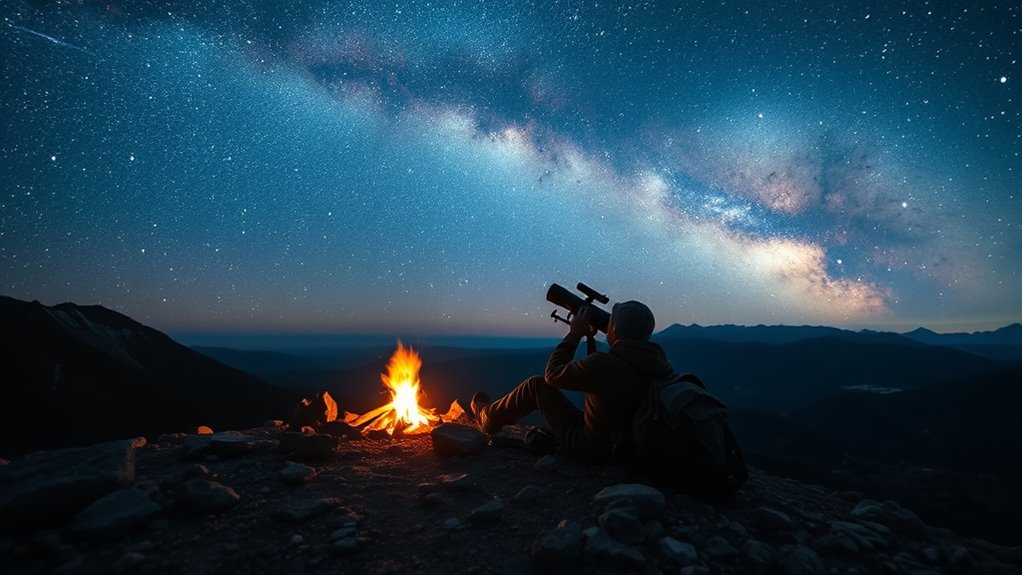If you’re seeking unforgettable stargazing adventures, explore remote dark sky reserves like Namibia’s NamibRand, New Zealand’s Aoraki Mackenzie, or Germany’s Westhavelland Wetlands, where light pollution is minimal and celestial views are stunning. Mountain observatories such as Pic du Midi in France offer high-altitude clarity, while desert environments like Chile’s Atacama or Jordan’s Wadi Rum provide pristine skies and unique landscapes. Discover more hidden gems and expert tips for planning your perfect cosmic journey.
Key Takeaways
- Explore remote dark sky reserves like Namibia’s NamibRand and New Zealand’s Aoraki Mackenzie for pristine celestial viewing.
- Visit European sites such as Westhavelland Wetlands and mountain observatories like Pic du Midi for high-quality stargazing.
- Experience guided night sky tours and public observatory sessions in regions like North York Moors and Tenerife.
- Enjoy desert and salt flat environments in Wadi Rum, Uyuni, and Atacama for surreal, mirror-like star reflections.
- Leverage high-altitude locations and advanced telescopes at renowned observatories for optimal astronomical observations.
Discovering the NamibRand Nature Reserve in Namibia

Nestled in the remote southwest of Namibia, the NamibRand Nature Reserve offers some of the world’s clearest and darkest night skies, making it a premier destination for stargazing enthusiasts. As you explore, you’ll be captivated by the desert sky’s brilliance, free from urban light pollution thanks to Namibia conservation efforts. Covering about 2,022 square kilometers, the reserve’s isolation—over 300 km from Windhoek and far from small communities—ensures pristine viewing conditions. The reserve earned Gold Tier status from the International Dark-Sky Association in 2012, highlighting its exceptional quality. During your visit, you can enjoy guided tours with professional astronomers, use state-of-the-art telescopes, and even stargaze from luxury guest suites with skylights. Namibia’s low population density and minimal artificial light pollution create an environment that is ideal for astronomical observation, providing a rare opportunity to witness celestial phenomena in their purest form. This unique environment combines desert landscapes with a commitment to Namibia conservation, offering an unforgettable celestial experience.
Exploring the Aoraki Mackenzie International Dark Sky Reserve in New Zealand
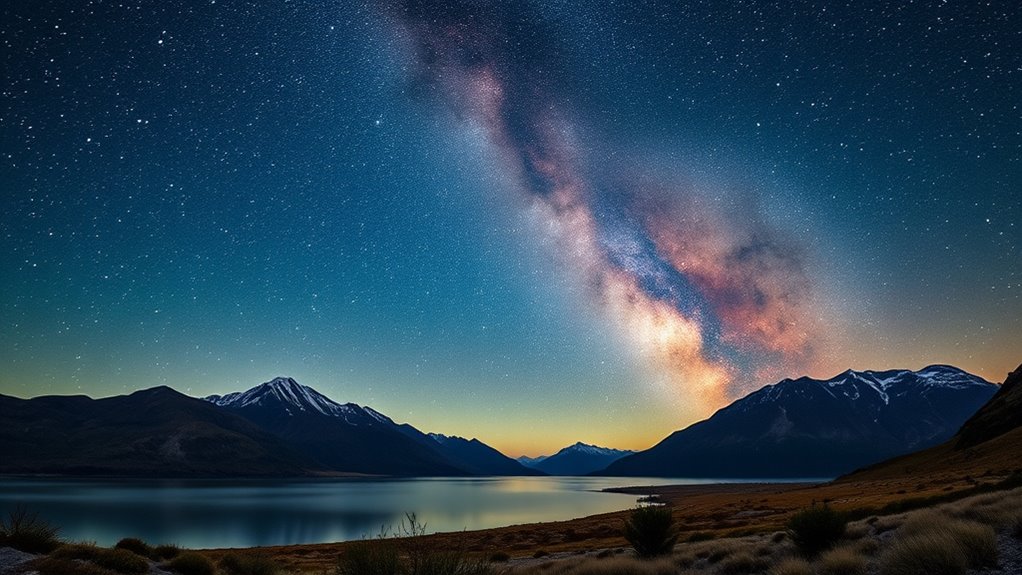
You’ll be amazed by the vast night sky views at Aoraki Mackenzie, where minimal light pollution offers some of the clearest stargazing experiences in the world. Public observatory tours provide a chance to learn about the stars and constellations from expert guides. With its dark skies and accessible facilities, this reserve makes it easy to enjoy unforgettable nights under the stars. The reserve’s protected status ensures the preservation of its pristine night environment for future generations to enjoy, supporting initiatives that promote astronomy experiences around the world.
Vast Night Sky Views
The Aoraki Mackenzie International Dark Sky Reserve offers some of the most breathtaking night sky views in the world, making it a must-visit destination for stargazing enthusiasts. Here’s what makes it extraordinary:
- Its nearly pristine skies with a Bortle scale rating of 2 allow for incredible celestial navigation, helping you spot constellations with ease. Located in the South Island of New Zealand, the reserve benefits from a remote location far from city lights, ensuring optimal darkness.
- Wide-open vistas provide perfect conditions for star trail photography, capturing stunning long-exposure images of the night sky.
- Surrounded by snow-capped mountains and glacial lakes, the backdrop enhances the visual experience, making every stargazing session memorable.
- The reserve’s minimal light pollution reveals a vast, unobstructed view of the Milky Way, planets, and distant stars, offering a truly awe-inspiring experience.
Public Observatory Tours
Exploring the Aoraki Mackenzie International Dark Sky Reserve through its public observatory tours offers a rare chance to experience some of the world’s clearest night skies. Thanks to strict controls on urban light pollution, you’ll enjoy brilliant views with minimal interference. Tours typically last 90 minutes to two hours, guided by astronomy experts who introduce you to the night sky’s wonders. You start with naked-eye viewing, then move to powerful telescopes, like the 16-inch scopes at Mount John, which require careful maintenance to guarantee peak performance. The remote, high-altitude locations provide ideal conditions, especially during the New Moon. It is the largest Gold Status International Dark Sky Reserve, which helps ensure optimal stargazing conditions. This status is awarded based on light pollution levels and conservation efforts, further enhancing the quality of viewing experiences. Tours also include cultural insights and may involve walking on gravel inclines, so dress warmly. Booking in advance is recommended for clear, weather-permitted nights.
Stargazing Amidst Wetlands at Westhavelland, Germany
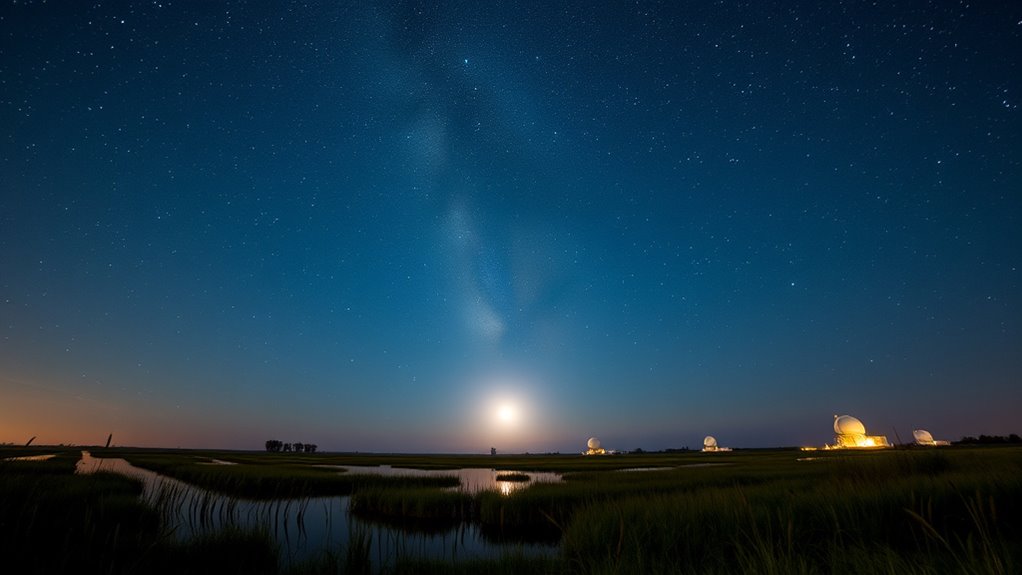
Stargazing at Westhavelland amidst its vast wetlands offers a breathtaking experience, especially because the area’s designation as an International Dark Sky Reserve guarantees minimal light pollution. As you look up, you’ll appreciate how the wetland ecosystems create a unique backdrop for celestial observation. Here are four reasons to visit:
Experience stunning stargazing amid pristine wetlands at Westhavelland’s Dark Sky Reserve.
- Pristine Night Skies – The reserve’s low light pollution reveals the full splendor of the Milky Way. The location’s status as the largest protected wetland in a European country supports conservation efforts that help maintain excellent conditions for star visibility. Maintaining the natural landscape is essential for preserving the rustic charm that enhances the overall ambiance for stargazing.
- Rich Wetland Ecosystems – The wetlands provide a scenic setting and support diverse flora and fauna.
- Nocturnal Wildlife – You might spot or hear nocturnal wildlife like owls and beavers during your stargazing session.
- Wildlife and Sky Conservation – The park’s protected status fosters both natural habitats and dark skies, making it a perfect blend of nature and astronomy.
Unveiling the Night Skies of North York Moors National Park, England

Uncovering the night skies of North York Moors National Park reveals a spectacular canvas of stars, thanks to its designation as a Dark Sky Discovery Site. With three “Milky Way class” sites—Dalby Forest, Sutton Bank, and Danby Lodge—you can enjoy clear views of the galaxy and practice star chart navigation. As the moon phases shift, you’ll find ideal moments for deep-sky observing. Sutton Bank’s accessible viewing areas and observatories make stargazing comfortable, especially during the park’s annual Dark Skies Festival. Nearby locations like Ribblehead Viaduct and Rievaulx Abbey offer perfect backdrops for astrophotography. Remember to check moon phases, bring star charts, and take advantage of dark skies-friendly accommodations, ensuring an unforgettable night under the stars. Additionally, utilizing vertical storage solutions can help you organize your gear and make your stargazing trips more efficient.
The High Altitude Wonders of Pic Du Midi, France

At Pic du Midi, you’ll experience some of the clearest night skies thanks to its high altitude and remote location. The mountain’s elevation reduces atmospheric interference, giving you exceptional views of stars and planets. This blend of natural conditions makes it one of the best spots for serious stargazing and astronomical observation. Located at 2,870 meters (9,420 ft) in the Pyrenees, the observatory’s environment is ideal for astronomical research and public viewing. Additionally, the area offers specialized telescopes and guided tours that enhance the experience for both amateur astronomers and seasoned scientists.
Mountain Observatory Insights
Have you ever wondered how scientists study the stars from some of the highest and most challenging terrains? At Pic du Midi, you’re venturing into a site with profound historical significance and cutting-edge technological innovations. Here’s what makes it special:
- Its construction began in 1878 and became a cornerstone of astronomical history.
- The observatory houses advanced telescopes like the 2-meter reflector and the famous 1.06-meter Cassegrain, both breakthroughs in optical technology.
- It played a key role in planetary discoveries, including discrediting Mars canal theories and aiding Apollo missions.
- Pioneering instruments like Bernard Lyot’s coronagraph advanced solar physics.
- Its high-altitude location minimizes atmospheric distortion, providing clearer views of celestial phenomena.
This high-altitude fortress continues to push scientific boundaries, blending a rich legacy with modern innovations in the pursuit of understanding the universe.
Night Sky Clarity
The high altitude of Pic du Midi creates ideal conditions for clear, dark skies by reducing atmospheric interference and moisture. Despite nearby urban areas, effective lighting abatement programs and regulations keep light pollution levels comparable to a dark sky site. This control allows you to see subtle sky phenomena, like faint meteors and zodiacal light, with exceptional clarity. The mountain’s atmospheric stability, thanks to its position in the lower troposphere and above clouds, minimizes atmospheric distortion and condensation. As a result, the skies are remarkably clear, offering stunning views of the Milky Way and winter constellations. The combination of altitude, low light pollution, and atmospheric stability makes Pic du Midi a premier destination for astronomers and stargazers seeking pure, unobstructed night sky experiences. Additionally, the unique atmospheric conditions at this elevation help reduce turbulence, providing superior viewing conditions for astronomical observations.
Astronomical Adventures in the Atacama Desert, Chile

Starting on an astronomical adventure in the Atacama Desert offers unparalleled opportunities to witness the cosmos in its purest form. Its desert sky remains crystal clear, with over 300 clear nights annually, perfect for uninterrupted observation. The high altitude of around 2,400 meters enhances altitude clarity, reducing atmospheric interference. Plus, minimal light pollution preserves the dark skies essential for stunning views. Here’s what makes it exceptional:
Discover unparalleled stargazing in the Atacama Desert’s clear, high-altitude skies with minimal light pollution.
- The desert sky’s transparency reveals deep-sky objects rarely seen elsewhere.
- High altitude improves clarity, making faint celestial phenomena more visible.
- Vast, barren terrain offers unobstructed horizons for panoramic stargazing.
- Renowned observatories like VLT and ALMA maximize your viewing potential.
- Utilizing a world clock tool can help plan your stargazing sessions across different time zones for optimal viewing times.
Experience the magic of these unique conditions and explore the universe like never before in this celestial haven.
Night Under the Stars in Tenerife’s Canary Islands
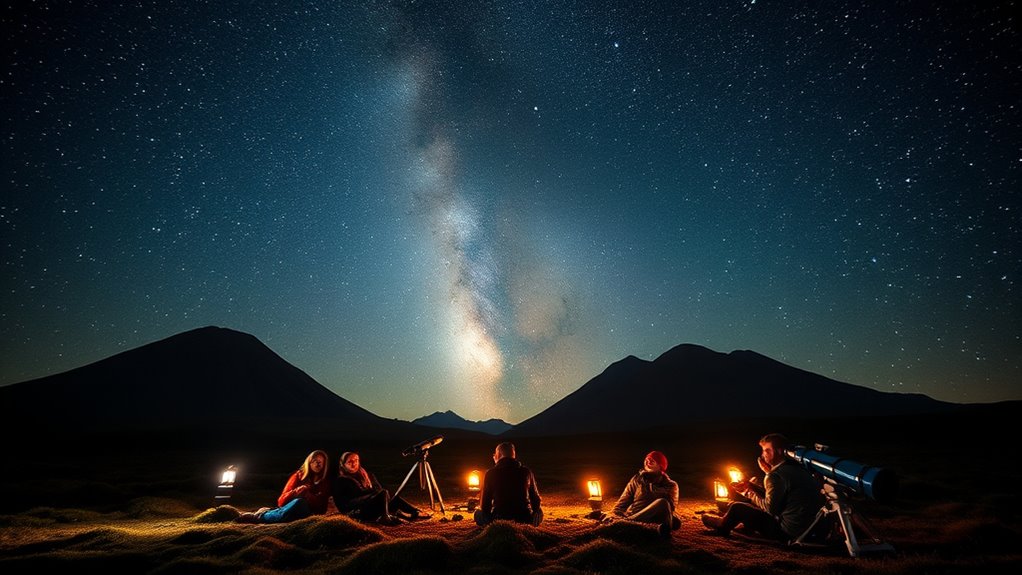
Discover the breathtaking night skies of Tenerife’s Canary Islands, where some of Europe’s top stargazing experiences await. The island boasts prime locations like Teide National Park, with Tenerife telescopes offering clear views of stars and deep sky objects, thanks to minimal light pollution and high altitude. During stargazing festivals, you can enjoy guided sessions at Parador de Las Cañadas, often featuring telescopes and expert astronomy instruction, especially during August’s Perseids meteor shower. Popular sites like El Palmar and Mirador del Pico del Inglés provide relaxed, accessible spots for self-guided viewing. Whether you’re attending guided tours, using telescopes, or simply gazing from remote areas, Tenerife offers exceptional opportunities to explore the night sky in a stunning, natural setting year-round. Additionally, engaging in astronomy experiences such as workshops and night sky photography can deepen your appreciation for the cosmos.
Experiencing the Desert Beauty of Wadi Rum, Jordan

Immersing yourself in the desert night sky of Wadi Rum reveals a stunning spectacle of stars, thanks to its dry, clear atmosphere and minimal light pollution. As you gaze upward, you’ll experience:
- The prominent visibility of the Milky Way during summer, illuminating the vast desert.
- Constellations like Orion, Taurus, and Gemini, easy to identify with guided help.
- Shooting stars and meteor showers, such as the Perseids in August, streaking across the sky.
- Deep-sky objects like galaxies and nebulae, visible through telescopes, connecting you to the universe.
- Advances in astronomy technology have enhanced our ability to observe distant celestial phenomena from remote locations like Wadi Rum, making the experience even more awe-inspiring.
Guided tours often include lessons in desert navigation and Bedouin traditions, sharing how star patterns historically guided travelers and shaped cultural practices. This blend of nature and heritage makes Wadi Rum a truly immersive stargazing experience.
Reflective Skies at the Uyuni Salt Flats in Bolivia
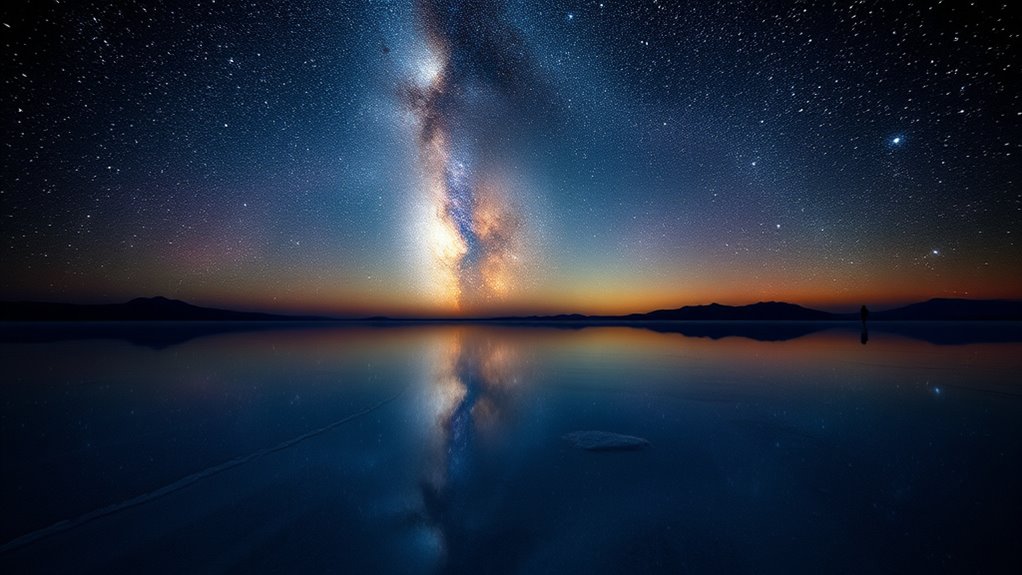
On the Uyuni Salt Flats in Bolivia, the vast, flat terrain creates a breathtaking backdrop for stargazing, especially during the rainy season when shallow pools of water transform the landscape into the world’s largest natural mirror. This mirror reflection doubles the stars’ brilliance, offering surreal night sky views. The salt flats’ smooth, expansive surface and minimal light pollution make celestial observation exceptional. Nearby volcanos and colorful mounds are reflected in the water, enhancing the visual spectacle. The contrast ratio of the natural environment plays a crucial role in the clarity of the reflected stars, making the experience even more mesmerizing.
Frequently Asked Questions
How Can I Find the Best Time for Stargazing During My Visit?
To find the best time for stargazing, check the moon phases and aim for the new moon, when the sky is darkest. Avoid nights near the full moon, as moonlight washes out faint stars. Also, consider weather conditions—clear, dry nights with minimal humidity provide the best visibility. Planning around these factors guarantees you’ll experience ideal stargazing, with darker skies and clearer conditions for observing celestial wonders.
Are There Any Safety Tips for Nighttime Outdoor Astronomy Activities?
Thinking safety’s optional? Think again! When you’re out star-gazing, you should be prepared for wildlife encounters and weather surprises. Use red flashlights to avoid startling animals, and keep noise to a minimum—fellow stargazers appreciate the quiet. Dress for the weather, watch your step on uneven ground, and stay aware of your surroundings. Respect nature, stay alert, and your night under the stars will be both magical and safe.
What Equipment Should I Bring for Optimal Stargazing Experiences?
For ideal stargazing, you should bring essential telescopic accessories like extra eyepieces and lens cleaning kits to keep your equipment in top shape. Don’t forget a sturdy tripod and a portable power source to guarantee your telescope and electronic devices stay operational during long sessions. Additionally, pack a red light flashlight, warm clothing, and comfortable seating to enhance your experience and stay prepared for changing conditions.
Do I Need Special Permits or Reservations to Access These Dark Sky Sites?
You might wonder about regulatory requirements and access restrictions at dark sky sites. Generally, many parks and reserves don’t need special permits, but some do, especially during peak seasons or for research. It’s best to check ahead, as some locations require reservations or permits to manage visitor flow and protect sensitive habitats. Always verify local rules to guarantee smooth access and enjoy your stargazing experience without surprises.
How Can I Participate in Local Astronomy Events or Guided Tours?
You can participate in local astronomy events or guided stargazing tours by reaching out to local astronomy clubs, which often host regular observing sessions and educational activities. Check their websites or social media for schedules and membership info. Many clubs offer guided tours, beginner workshops, and public star parties. Joining these groups makes it easy to access expert-led events, and they often welcome newcomers enthusiastic to learn and enjoy the night sky.
Conclusion
As you chase the celestial dance across the globe, each starlit sky becomes a shimmering tapestry woven with wonder. From deserts to wetlands, darkness reveals a universe alive with magic, whispering secrets of the cosmos. Your journey under these radiant vaults isn’t just about gazing upward—it’s about feeling the universe’s heartbeat sync with yours. So, let the stars guide you, and may your soul forever sparkle with celestial fire.
